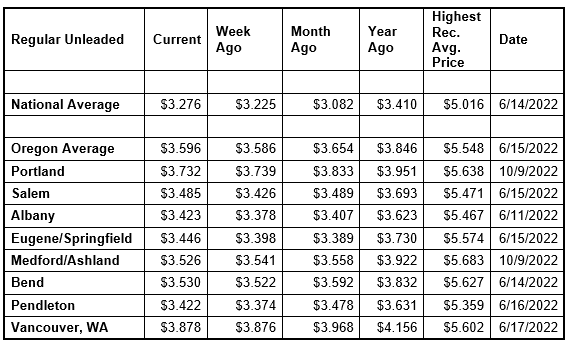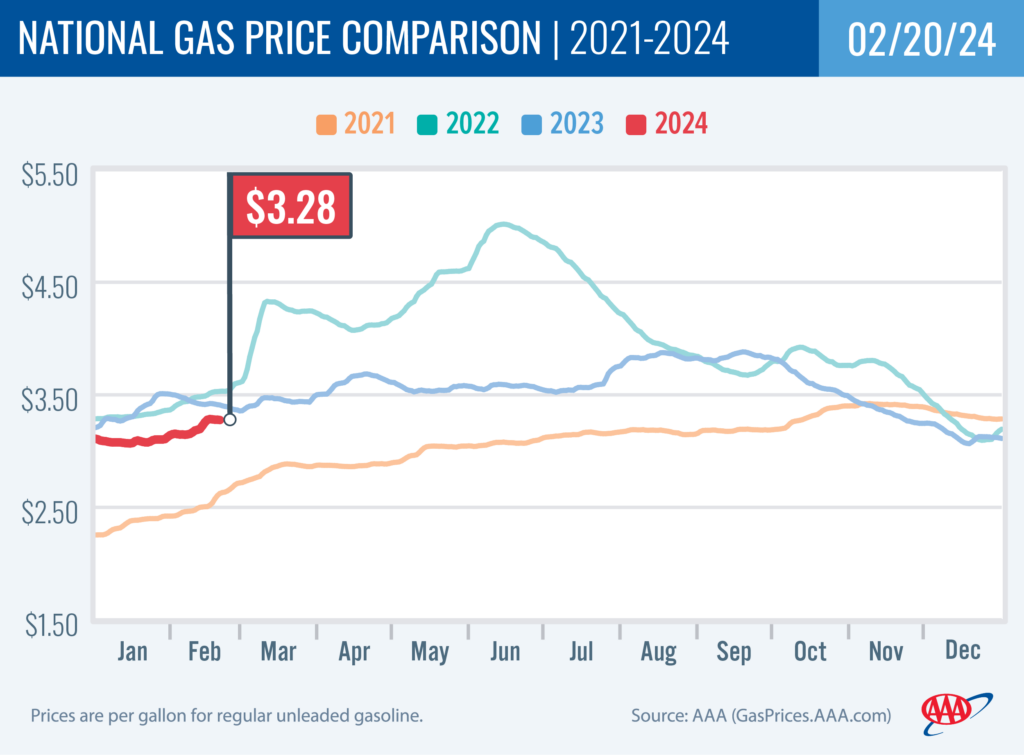PORTLAND, Ore., – Refinery issues have sent gas prices higher in the Midwest, pushing the national average price of gas higher as well. Here in Oregon, pump prices are ticking up. This is the time of year for the seasonal climb in gas prices due to refinery maintenance and the switch to EPA-mandated summer-blend fuel. For the week, the national average for regular rises five cents to $3.28 a gallon. The Oregon average adds a penny to $3.60.

A major driver of higher gas prices nationwide is a shutdown at the large BP-Whiting refinery in Indiana, which was taken offline after a Feb. 1 power outage. The facility has undergone extensive inspections to assess damage. The shutdown has had an impact on supplies, as the refinery normally processes 435,000 barrels of crude oil per day. This has sent prices higher throughout the Midwest and has also pushed the national average higher.
“This is the time of year that gas prices climb. Refineries typically run the last of their winter-blend fuels, then undergo maintenance ahead of the switch to summer-blend fuel. This process can temporarily reduce supplies, putting upward pressure on pump prices,” says Marie Dodds, public affairs director for AAA Oregon/Idaho. “So far, Oregon prices have mostly ticked down over the last four weeks while prices in other parts of the country have climbed. The Oregon average rose a penny in the last week, which is a small increase compared to other areas.”
All counties in Oregon except Curry ($4.08) have averages below $4 a gallon. The Oregon average began 2024 at $3.79 a gallon compared to $3.60 today. The national average started the year at $3.11 and has climbed to $3.28 today.
Gas prices normally rise in the first and second quarters of the year. The factors include refinery maintenance season, the normal seasonal growth in demand, and the federally mandated switch from winter-blend fuel to summer-blend, which is more expensive to produce. Summer-blend gas helps reduce emissions from gasoline during the warm summer months. More info on summer- and winter-blend gasoline can be found at the EPA website.
Crude oil prices rallied last week, largely due to ongoing tensions in the Middle East. U.S. crude added about 3% for the week, setting at about $79 a barrel which is the highest price since Nov. 6. Crude prices have been volatile since the attack on Israel by Hamas in October. While Israel and the Palestinian territory are not oil producers, there’ve been concerns that the conflict could spread in the Middle East, which could potentially impact crude production in other oil-producing nations in the region.
Crude oil is trading around $77 today compared to $78 a week ago and $77 a year ago. In 2023, West Texas Intermediate ranged between $63 and $95 per barrel. Crude reached recent highs of $123.70 on March 8, 2022, shortly after the Russian invasion of Ukraine, and $122.11 per barrel on June 8, 2022. The all-time high for WTI crude oil is $147.27 in July 2008.
Crude oil is the main ingredient in gasoline and diesel, so pump prices are impacted by crude prices on the global markets. On average, about 56% of what we pay for in a gallon of gasoline is for the price of crude oil, 8% is refining, 19% distribution and marketing, and 16% are taxes, according to the U.S. Energy Information Administration.
Demand for gas in the U.S. decreased from 8.81 to 8.17 million b/d for the week ending February 9, according to the U.S. Energy Information Administration (EIA). This compares to 8.27 million b/d at the same time last year. Meanwhile, total domestic gasoline stocks declined by 3.7 million bbl to 247.3 million bbl.
Lower gas demand would typically help push pump prices down, but fluctuating oil prices and tight gas supply increase prices.
Quick stats
Oregon is one of 46 states and the District of Columbia with higher prices now than a week ago. Indiana (+15 cents) has the largest week-over-week gain. Michigan (-6 cents) has the biggest weekly drop. Washington, Texas, Oregon, Maine and Nevada all have the smallest weekly gains in the nation at one cent each.
Hawaii ($4.69) has the most expensive gas in the nation for the seventh week in a row. California ($4.65) is second. These are the only two states with averages at or above $4, same as a week ago. This week 33 states and the District of Columbia have averages in the $3-range. Fifteen states have averages in the $2 range this week.
The cheapest gas in the nation is in Oklahoma ($2.83) and Mississippi ($2.86) and. No state has had an average below $2 a gallon since January 7, 2021, when Mississippi and Texas were below that threshold.
The difference between the most expensive and least expensive states is $1.86 this week, compared to $1.97 a week ago.
Oregon is one of only three states with lower prices now than a month ago. The national average is 19 cents more and the Oregon average is six cents less than a month ago. This is the largest monthly drop in the nation. Florida (+34 cents) has the largest monthly increase.
Oregon is one of 45 states and the District of Columbia with lower prices now than a year ago. The national average is 13 cents less and the Oregon average is 25 cents less than a year ago. Colorado (-$1.19) has the largest yearly decrease. Maryland (+9 cents) has the largest year-over-year increase.
West Coast
The West Coast region continues to have the most expensive pump prices in the nation with six of the seven states in the top 10. It’s typical for the West Coast to have six or seven states in the top 10 as this region tends to consistently have fairly tight supplies, consuming about as much gasoline as is produced. In addition, this region is located relatively far from parts of the country where oil drilling, production and refining occurs, so transportation costs are higher. And environmental programs in this region add to the cost of production, storage and distribution.
| Rank | Region | Price on 2/20/24 |
| 1 | Hawaii | $4.69 |
| 2 | California | $4.65 |
| 3 | Nevada | $3.91 |
| 4 | Washington | $3.91 |
| 5 | Oregon | $3.60 |
| 6 | Pennsylvania | $3.55 |
| 7 | Illinois | $3.51 |
| 8 | Alaska | $3.45 |
| 9 | District of Columbia | $3.43 |
| 10 | Maryland | $3.38 |
As mentioned above, Hawaii has the most expensive gas in the country for the seventh week in a row. California, Nevada, Washington, and Oregon round out the top five. Alaska is eighth. Arizona is 11th. Oregon is fifth most expensive for the 18th week in a row.
Five of the seven states in the West Coast region are seeing week-over-week increases: Arizona (+12 cents), California (+3 cents), Nevada (+1 cent), Oregon (+1 cent), and Washington (+1 cent). Alaska (-1 cent) and Hawaii (-1 cent) have week-over-week declines.
The refinery utilization rate on the West Coast fell from 78.6% to 76.4% for the week ending February 9. This rate has ranged between about 73% to 96% in the last year. The latest national refinery utilization rate dropped from 82.4% to 80.6%.
According to EIA’s latest weekly report, total gas stocks in the region fell from 32.49 million bbl.to 31.96 million bbl.
A lower refinery utilization rate and a decrease in gasoline stocks can put upward pressure on pump prices.
Oil market dynamics
Crude oil prices rose last week largely due to continuing tensions in the Middle East and ongoing fears that the war in Gaza could spread in the region. Also, the EIA reported that total domestic commercial crude stocks increased significantly by 12 million bbl to 439.4 million bbl last week. The sharp increase in supply signals that oil demand could be loosening, which helped offset some price increases.
At the close of Friday’s formal trading session, WTI rose $1.16 to settle at $79.19, the highest price since Nov. 6. U.S. markets were closed Monday in observance of President’s Day. Today crude is trading around $77 compared to $78 a week ago. Crude prices are about $1 more than a year ago.
Drivers can find current gas prices along their route with the free AAA Mobile app for iPhone, iPad and Android. The app can also be used to map a route, find discounts, book a hotel and access AAA roadside assistance. Learn more at AAA.com/mobile.

Diesel
For the week, the national average climbs five cents to $4.09 a gallon. The record high is $5.816 set on June 19, 2022. The Oregon average rises two cents to $4.14. The record high is $6.47 set on July 3, 2022. A year ago the national average for diesel was $4.49 and the Oregon average was $4.75.
Find current fuel prices at GasPrices.AAA.com.
AAA news releases, high resolution images, broadcast-quality video, fact sheets and podcasts are available on the AAA NewsRoom at NewsRoom.AAA.com.
Find local news releases at https://oregon.aaa.com/community/media/media-contacts.html
Fuel prices are updated daily at AAA’s Daily Fuel Gauge at AAA Gas Prices. For more info go www.AAA.com. AAA Oregon/Idaho provides more than 890,000 members with travel, insurance, financial and automotive-related services, and is an affiliate of AAA National, serving more than 64 million motorists in North America.

